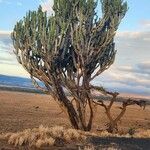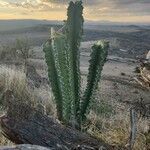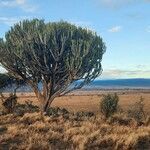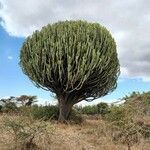Tree to 12(–20) m. high, with a simple trunk to ± 90 cm. in diameter and rough fissured grey bark; branches persistent from ± 3 m. upwards, suberect, densely rebranching to form eventually a large broadly rounded crown; terminal branchlets fleshy, (3–)4(–5)-angled, 5–10 cm. wide, ± square in cross-section to distinctly winged, with wings to 2.5 cm. wide, usually ± constricted at irregular intervals into oblong segments 15–25 cm. long; angles straight to shallowly sinuately toothed, with teeth 1–1.5 cm. apart.. Spine-shields very obtusely triangular, to ± 8 × 7 mm., extending ± 5 mm. above to include the flowering eye; spines stout, to 5 mm. long; prickles flexible, triangular, 1.5 mm. long, soon deciduous; spines and spine-shields soon becoming corky, rusty-brown and disintegrating.. Leaves oblanceolate on seedlings and young growth, to 7 × 1.5 cm., deltoid on older growth and soon deciduous, ± 5 × 5 mm.. Cymes 1–6 crowded together, 1-forked, with stout peduncles 5–20 mm. long and cyme-branches ± 5 m. long; bracts rounded, ± 5 × 6 mm.. Cyathia ± 4 × 9 mm., with broadly cup-shaped involucres; glands transversely elliptic, ± 2 × 4 mm., almost touching, golden yellow; lobes transversely elliptic, ± 2.2 × 3 mm.. Male flowers many: bracteoles spathulate, plumose; stamens 5.8 mm. long.. Female flower: perianth irregularly divided into 3 or more filiform lobes 2–4 mm. long, sometimes with 1 or 2 teeth; styles 2 or 3, ± 3 mm. long, joined at the base, apices thickened, rugulose, bifid.. Capsule shortly exserted on a stout pedicel ± 5 mm. long, 2–3-locular, subglobose, ± 8 × 12 mm., fleshy, green becoming red, hardening immediately before dehiscence to ± 6 × 9 mm. and very obtusely 2–3-lobed.. Seeds subglobose, slightly compressed laterally, 3 mm. in diameter, greyish brown speckled with paler brown, smooth.
More
A tree. It grows 12-20 m tall. The trunk can be 90 cm across. The bark is grey and rough and cracked. The leaves are broadly sword shaped and 7 cm long by 1.5 cm wide. Male and female flowers are separate. The fruit capsule has 2-3 lobes and it 8 mm long by 12 mm wide. The seeds are 3 mm across.
Dry deciduous and evergreen open wooded grasslands, on rocky slopes, sometimes on termite mounds; at elevations from sea-level up to 2,200 metres.
Can be grown by cuttings or seedlings. Seeds needs soaking.






